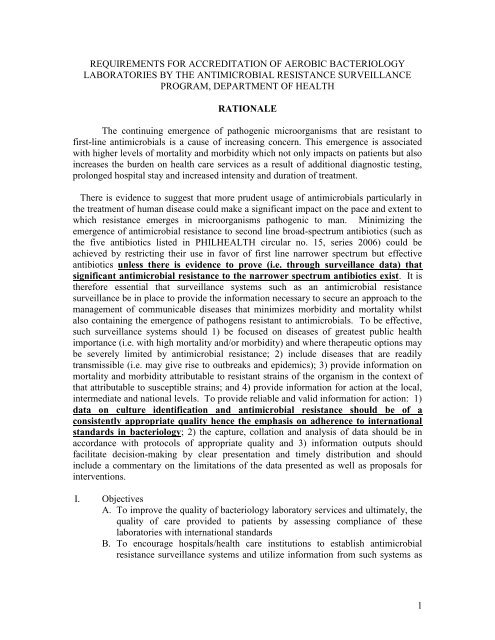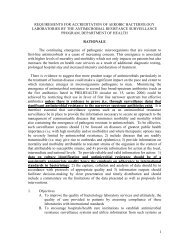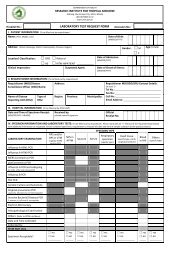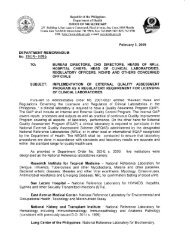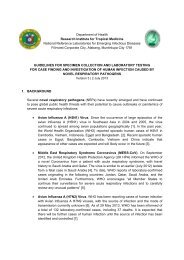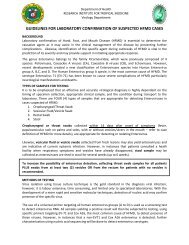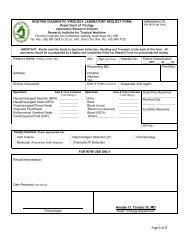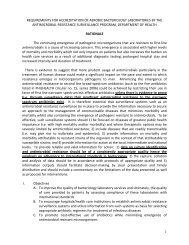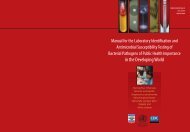Download - Research Institute for Tropical Medicine
Download - Research Institute for Tropical Medicine
Download - Research Institute for Tropical Medicine
- No tags were found...
Create successful ePaper yourself
Turn your PDF publications into a flip-book with our unique Google optimized e-Paper software.
asis <strong>for</strong> selecting appropriate antibiotic regimens <strong>for</strong> treatment of infectiousdiseasesC. To promote cost-effective use of antibiotics while minimizing emergence ofantimicrobial resistant microorganismsII. Definition of TermsA. Antimicrobial Resistance Surveillance Program – a program of theDepartment of Health which monitors the current levels and developing trendsof antibiotic resistance of aerobic bacteria of public health importance andper<strong>for</strong>ms reference laboratory functions related to antimicrobial resistance,with the goal being to utilize such data as basis <strong>for</strong> rational antibiotic useB. Aerobic bacteriology laboratory – laboratory which deals with culture,isolation, identification, susceptibility testing of aerobic pathogens fromhuman samplesC. Tertiary Laboratory – a laboratory per<strong>for</strong>ming primary and secondary servicecapabilities in addition to but not limited to the following: special chemistry,special hematology, immunology/serology, microbiology (culture andsensitivity, aerobic and anaerobic, and KOH)D. Accreditation – the act of granting recognition to an institution whichmaintains suitable standards and specific requirements set by an officialreview boardE. Licensing – is the process of issuance of document as proof of official or legalpermission to operate a clinical laboratoryF. Hospital epidemiologist - hospital personnel who studies the causes,distribution, and control of diseases in patient populations based on datagenerated by the hospital. In relation to the analysis and interpretation of datafrom an antimicrobial resistance surveillance system, a person with training ininfectious diseases may have the most relevant qualification to act as hospitalepidemiologist.G. Clinical microbiologist – a professional focusing on infectious diseasediagnosis (with emphasis on identifying bacterial agents of infection),treatment and surveillance working in collaboration with health careprofessionalsH. Technical consultant- a professional responsible <strong>for</strong> the technical andscientific oversight of the laboratory. The technical consultant is not requiredto be on-site at all times when testing is per<strong>for</strong>med, however, he or she mustbe available to the laboratory on an as needed basis to provide consultation.2
III. Accreditation Requirements1. The laboratory applying <strong>for</strong> accreditation must have a valid license issued by theBureau of Health Facilities and Services of the Department of Health or theappropriate Center <strong>for</strong> Health Development under whose jurisdiction thelaboratory is located.2. Microbiology laboratories should achieve or exceed the standards set in thefollowing references be<strong>for</strong>e filing an application <strong>for</strong> accreditation:a. Manual <strong>for</strong> the Laboratory Identification and Antimicrobial SusceptibilityTesting of Bacterial Pathogens of Public Health Importance by the U.S.Centers <strong>for</strong> Disease Control and Prevention and World HealthOrganization, 2003 OR Basic Laboratory Procedures in ClinicalBacteriology. World Health Organization, Geneva, 1991 (The <strong>for</strong>mer canbe downloaded from the RITM website)b. Surveillance standards <strong>for</strong> antimicrobial resistance by the World HealthOrganization (WHO/CDS/CSR/DRS/2001.5) (Document can bedownloaded from the RITM website). The hospital antimicrobialresistance surveillance system should monitor the antimicrobial resistancepatterns of the following microorganisms at a minimum: Streptococcuspneumoniae, Haemophilus influenzae, Moraxella catarrhalis, Neisseriameningitidis, Neisseria gonorrhea, Salmonella, Shigella, Vibrio cholera,Escherichia coli, Klebsiella sp., Pseudomonas aeruginosa, andStaphylococcus aureus. The ARSRL can receive bacterial isolates withunusual susceptibility patterns as listed in Annex A <strong>for</strong> confirmatorytesting. Please follow the guidelines in Annex B. Cost of confirmatorytests are as follows: 1) re-identification - P 850.00; 2) quantitativesusceptibility test per antibiotic - P 1,000.00; and 3) Salmonellaserotyping – P 15,000.c. If the antimicrobial susceptibility method utilized in the laboratory is diskdiffusion, the following are the references from the Clinical andLaboratory Standards <strong>Institute</strong> (<strong>for</strong>merly NCCLS): a) Per<strong>for</strong>manceStandards <strong>for</strong> Antimicrobial Disk Susceptibility Tests, 10 th edition, (M02-A10, vol 29 no. 1), and b) Per<strong>for</strong>mance Standards <strong>for</strong> AntimicrobialSusceptibility Testing, 20 th In<strong>for</strong>mational Supplement, January 2010 (M-100-S20, volume 30 no. 1).d. For antimicrobial resistance surveillance networks, it is equally importantto realize that data generated <strong>for</strong> clinical purposes will need to be adapted<strong>for</strong> epidemiological use. There<strong>for</strong>e, culture and antimicrobialsusceptibility data should additionally be collated and managed using avalid software, preferably the WHONET in order to facilitate collation andanalysis of antimicrobial susceptibility data. Laboratories with an existingsoftware program can utilize the software BACLINK to convert thedatabase to the WHONET <strong>for</strong>mat. WHONET and BACLINK can bedownloaded at http://www.who.int/emc/WHONET/WHONET.html. Thedata outputs should contain the following in<strong>for</strong>mation at the minimum:name of patient including the full middle name, date of birth, sex, patientlocation (ward where admitted or OPD as the case may be), date of3
admission (if admitted), date test requested, specimen source, name ofrequesting physician, type of test requested, hospital or case number,results of culture and antimicrobial susceptibility tests. For purposes ofcompliance with standards <strong>for</strong> reporting in accordance with InternationalHealth Regulations (IHR) of 2005 which became effective on June 2007in all member countries of the World Health Organization, a list o<strong>for</strong>ganisms that are reportable in accordance with IHR (2005) and Annex 2of the IHR (2005) document must be available in the laboratory includingevidence to prove that such organisms when identified in bacteriology labare reported to the National Epidemiology Center (NEC) or their localcounterparts. The IHR (2005) document can be accessed at the WHOwebsite (www.who.int/eml)3. Additionally, aerobic bacteriology laboratories should participate and per<strong>for</strong>msatisfactorily in the External Quality Assessment Program (EQAP) to beconducted by the ARSP to be given accreditation. The EQAP guidelines are asfollows:a. Participation in the proficiency testing will require a payment of P5,500.00per dispatch. A laboratory can request <strong>for</strong> a second sample of any of theEQAP organisms; however, such requests should be sent to the ARSPwithin 2 weeks from initial dispatch together with payment of P 1,100.0per organism requested. Prices are subject to change without prior notice.b. Proficiency testing samples will be distributed by the ARSP on October6, 2010. However, since validity of accreditation is 3 years as stipulatedin item IVC2, laboratories with valid accreditations are required to takethe EQAP only at the time of application <strong>for</strong> renewal of accreditation. Theyearly distribution of EQAP is intended to accommodate laboratories whowish to apply <strong>for</strong> accreditation <strong>for</strong> the first time or those who failed in thepreceding year’s EQAP.c. 5 unknown samples will be given <strong>for</strong> identification and susceptibility.d. Answers should be sent through courier and received at the ARSP officenot later than 3 weeks after dispatch.e. Feedback will be provided 3 weeks after submission of EQAP results.f. A rating of 75% or better is considered satisfactory per<strong>for</strong>mance in theEQAP. Labs passing the EQAP 2010 will undergo inspection. Labswhich failed the EQAP will automatically be denied accreditation.4. A rating of at least 75% is considered satisfactory per<strong>for</strong>mance during inspection.a. The laboratory shall make available to the accrediting body at anyreasonable time, the premises, pertinent records, and facilities where thelaboratory examinations are being per<strong>for</strong>med <strong>for</strong> inspection.a. Feedback shall be provided to each laboratory by inspectors after visit.5. To get accreditation, laboratories should obtain a score of at least 75% in BOTHthe EQAP and inspection.6. Accreditation will be valid from July 1, 2011-June 30, 2014.7. Participation in ARSP accreditation will be recognized as participation in thebacteriology component of the RITM NEQAS which is implementedbeginning year 2009 as a component of the Revised Rules and Regulations4
Governing the Licensure and Regulation of Clinical Laboratories in thePhilippines (AO No. 2007-0027). Thus, laboratories with ARSP accreditationor have undergone EQAS under ARSP accreditation will no longer be askedto take the bacteriology component of the RITM NEQAS. These laboratorieswill then only be asked to undergo the parasitology and TB microscopyand/or culture components. Consequently, laboratories which haveparticipated in ARSP accreditation have to pay only fifty percent (50%) ofthe RITM NEQAS fee.IV. Initial AccreditationA. Documents to be accomplished:1. Duly notarized application <strong>for</strong>m. The application <strong>for</strong>m can be downloadedfrom the website of the <strong>Research</strong> <strong>Institute</strong> <strong>for</strong> <strong>Tropical</strong> <strong>Medicine</strong> (RITM) –www.ritm.gov.ph. Filled up application <strong>for</strong>ms should be received at theARSRL office on or be<strong>for</strong>e 12 noon of the last working day of August ofevery year.2. Photos of the Exterior and Interior design of the laboratory including floorplan.B. Procedures <strong>for</strong> accreditation1. The applicant submits his application <strong>for</strong>m and pays a total of P 7,000.00(non-refundable) (P 1,500 application fee and P 5,500 EQAP fee) to theARSP office by courier, in person or directly to the <strong>Research</strong> <strong>Institute</strong> <strong>for</strong><strong>Tropical</strong> <strong>Medicine</strong> LandBank Muntinlupa Bank Account Number 03921024 77. If payment will be through bank deposit, applicant shouldindicate in the deposit slip the purpose of payment (application <strong>for</strong> ARSPaccreditation) and the name of the hospital. The applicant should FAX onthe same day that the deposit was made a copy of the deposit slip to ARSP(02-8099763). A corresponding official receipt which reflects the depositdate will be sent to the applicant together with the proficiency testingsamples. Sending payment by postal money order is discouraged becauseof logistic difficulties it can pose on ARSP.2. The ARSP staff shall evaluate submitted documents <strong>for</strong> completeness ofdata. If deficiencies are noted, the ARSP shall notify the applicant tocomply with the necessary requirements.3. With respect to laboratory inspection, the applicant shall shoulder thecost of travel, accommodation and other reasonable expenses of theinspection team.3.1 Inspection may be announced or unannounced at any reasonable time.3.2 The inspection team will consist of at least 2 personnel.3.3 The applying laboratory will be provided a bill listing down theestimate of expenses in connection with its laboratory’s inspection.5
Please refer to attached table <strong>for</strong> schedule of fees to be shouldered byapplying laboratory. Fees are subject to change without prior notice.3.4 Details of payment <strong>for</strong> laboratory inspection will be provided in acommunication to the laboratory. Funds <strong>for</strong> expenses <strong>for</strong> inspectionshall be transferred to the RITM bank account.mentioned in B.1above.C. Issuance of certificate of accreditation1. The ARSP shall issue a certificate of accreditation to the aerobicbacteriology laboratory upon meeting the requirements. A copy will begiven to the PhilHealth.2. The certificate of accreditation is valid <strong>for</strong> 3 years.V. Renewal of AccreditationVI. Queries1. The aerobic bacteriology accreditation shall be renewed every 3 years.2. Applications shall be received at the ARSRL <strong>for</strong> renewal ofaccreditation on or be<strong>for</strong>e 12 noon of the last working day of Augustof the year be<strong>for</strong>e accreditation expires.3. Any laboratory that fails to complete procedures and requirements <strong>for</strong>renewal of accreditation prior to the date of expiration of its accreditationshall automatically lose its accreditation on the expiry date indicated in itscertificate of accreditation without prior notice. A laboratory may haveits accreditation reinstated only upon submission of documents andcompletion of procedures <strong>for</strong> renewal of accreditation.4. The documents and procedures required <strong>for</strong> renewal of accreditation shallbe the same as those <strong>for</strong> initial accreditation.5. The procedures <strong>for</strong> application <strong>for</strong> renewal of accreditation are containedin the initial accreditation requirements IV. A and B. Compliance toaccreditation standards is expected of laboratories at all times.Laboratories shall be subjected to monitoring/inspection at any given timeas deemed necessary by ARSP.1. All queries should be addressed to Dr. Celia Carlos, Head, AntimicrobialResistance Surveillance Program, <strong>Research</strong> <strong>Institute</strong> <strong>for</strong> <strong>Tropical</strong><strong>Medicine</strong>, Filinvest Corporate City, Alabang, Muntinlupa, Metro Manila2. TELEFAX: (02) 809-97-63 or (02) 807-26-28 up to 32 local 609PLEASE CHECK THE RITM WEBSITE FROM TIME TO TIMEFOR ANY UPDATES.6
ANNEX ABACTERIA WITH UNUSUAL SUSCEPTIBILITY PATTERNS 2009OrganismResistant to the following antibiotic disks1. Beta-hemolytic Streptococci Ceftriaxone LinezolidCefepimeVancomycinErythromycin DaptomycinPenicillin2. ALL Enterobacteriaceae* CarbapenemsErtapenem, Imipenem, Meropenem3 rd Generation CephalosporinsCefotaxime, Ceftazidime, Ceftriaxone3. Enterococcus species AmpicillinHigh-Level Aminoglycoside(Gentamicin – 120 Mcg, Streptomycin – 300 mcg)PenicillinLinezolidVancomycin4. H. influenzae & H. parainfluenza All isolates to be referred5. Neisseria gonorrhoeae Ciprofloxacin SpectinomycinCeftriaxoneTetracyclineCefixime6. Neisseria meningitides Ampicillin CiprofloxacinAzithromycinMeropenemCefotaximePenicillinCeftriaxoneRifampicinChloramphenicol7. Pseudomonas aeruginosa*CefepimeMeropenemImipenemErtapenemCarbapenems8. Stenotrophomonas Maltophilia(Ertapenems, Imipenem, Meropenem)Cotrimoxazole9. Salmonella species*9.1. Typhoidal Salmonella sppAmpicillinCotrimoxazole9.1.1 Salmonella Paratyphi A CeftriaxoneCiprofloxacin9.1.2 Salmonella TyphiChloramphenicol Ofloxacin9.2. Nontyphoidal Salmonella spp All isolates to be referred10. Shigella species All isolates to be referred11. Staphylococcus speciesS. aureusS. epidermidisS. lugdunensisS. haemolyticusS. schleiferiCefoxitinDaptomycinErythromycinLinezolidOxacillinVancomycin12. Streptococcus pneumoniae All isolates to be referred13. Streptococcus species Viridans group Ampicillin DaptomycinPenicillinVancomycin14. Vibrio cholerae (all serotypes) Tetracycline* For ESBL, ampC and Carbapenemase screeningReferences: 1. CLSI 20092. Antibiotic Susceptibility Testing by the CDS Method – Online edition, 20097
ANNEX BGUIDELINES FOR SHIPMENT OF BACTERIAL ISOLATESINTRODUCTION:Submission of bacterial isolates that must be sent to distant/ reference laboratories <strong>for</strong>further testing and confirmation requires transportation by mail or through courierservices must follow the requirements of the Interstate shipment of Etiologic Agents code(Federal Regulations).PREPARATION OF BACTERIAL ISOLATES1. Revive the bacterial isolates onto desired culture media.2. Incubate plates at 35 C – 37 C <strong>for</strong> 18-24 hours except <strong>for</strong> fastidiousorganisms which maybe incubated at enhance 5-10% CO2 content.3. Check the viability and purity of the culture.4. Inoculate the isolates onto the tube with appropriate transport media used.OrganismTransport MediumEnterobacteriaceaeNutrient agar butt/ slantEnteric pathogens:Salmonella / ShigellaV. cholerae 01 / other VibriosNutrient agar butt / slantSemi-solid nutrient agar with 1% NaClStaphylococcus spp.Nutrient agar butt / slantS. pneumoniae and other Streptococcus spp. Sheep blood agar / Chocolate agar slantH. influenzae Chocolate agar slantNeisseria gonorrhoeaeChocolate agar slant overlaid with mineral oil5. Incubate tubes to its required temperature.PACKING OF BACTERIAL ISOLATES (DOUBLE PACK CONTAINER)In most instances, microbiological specimens can be satisfactorily shipped through mailwith special precautions against breakage and subsequent contamination of the mailingcontainer.A. Volume not exceeding 50 ml.Material should be placed in a securely closed, watertight container [primarycontainer [test tube, vial, etc]] which shall be enclosed in a second, durable watertightcontainer [secondary container]. Several primary containers may be enclosed in a singlesecondary container, if the total volume of all the primary containers so enclosed does notexceed 50 ml. The space at the top, bottom, and sides between the primary and secondary8
containers shall contain sufficient nonparticulate absorbent material [e.g. paper towel] toabsorb the entire contents of the primary containers[s] in case of breakage or leakage.Each set of primary and secondary containers shall then be enclosed in an outer shippingcontainer constructed of corrugated fiberboard, cardboard, wood, or other material ofequivalent strength.B. Volume greater than 50 ml.Packaging of material in volumes of 50 ml or more shall comply withrequirements specified in paragraph [a] of this section. In addition, a shock absorbentmaterial, in volume at least equal to that of the absorbent material between the primaryand secondary containers, shall be placed at the top, bottom, and sides between thesecondary container and the outer shipping container. Single primary containers shall notcontain more than 1,000 ml of material. However, two or more primary containers whosecombined volumes do not exceed 1,000 ml may be placed in a single, secondarycontainer. The maximum amount of etiologic agent which may be enclosed within asingle outer shipping container shall not exceed 4,000 ml.C. Labels1. The outer shipping container of all materials containing etiologic agentstransported must bear a label as illustrated and described below:UN 33732. The label must be in the <strong>for</strong>m of a square set at an angle of 45 o (diamond shaped)with each side having a length of at least 50 mm, the width of the line must be atleast 2 mm, and the letters at least 6 mm high. If an airway bill is used, the“Nature and Quantity of Goods Box” must show the text “DIAGNOSTICSPECIMENS”, “CLINICAL SPECIMENS”, or “BIOLOGICAL SUBSTANCECATEGORY B” and “UN 3373”.3. Other labels to be placed outside the outer shipping container include thefollowing:Name of Consignee (Label 1)Name of Shipper (label 2)Infectious Substance label• Infectious Substance Affecting Humans (Label 3)9
4. Damaged packages• “Up arrows” label (Label 4)The carrier shall promptly, upon discovery of evidence of leakage or any otherdamage to packages bearing Etiologic Agents/Biomedical Material label, isolatethe package shall notify the Head, Antimicrobial Resistance Surveilance Program,<strong>Research</strong> <strong>Institute</strong> <strong>for</strong> <strong>Tropical</strong> <strong>Medicine</strong>, Filinvest Corporate City, Alabang,Muntinlupa, Metro Manila, by telephone (02) 809-9763 . The carrier shall alsonotify the sender.10


